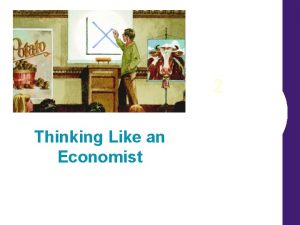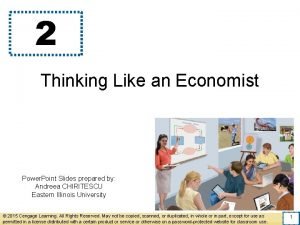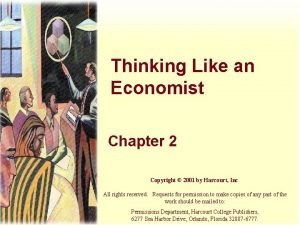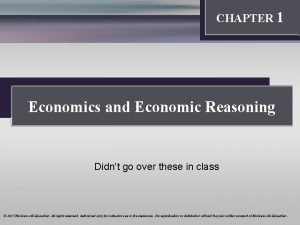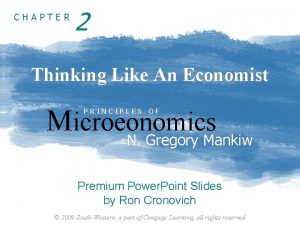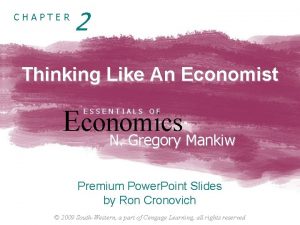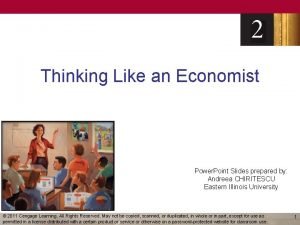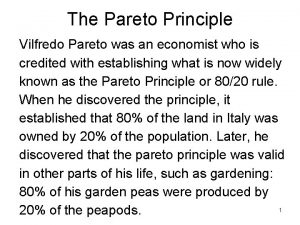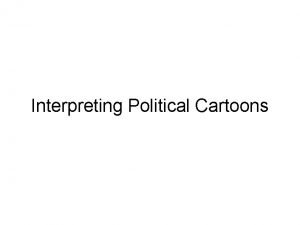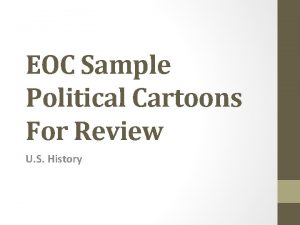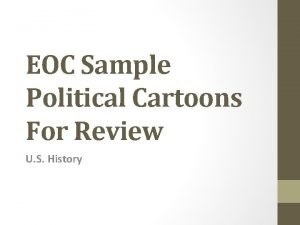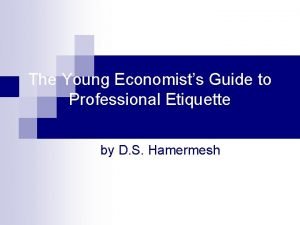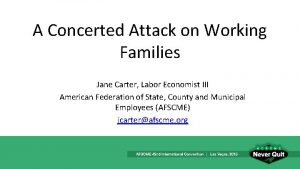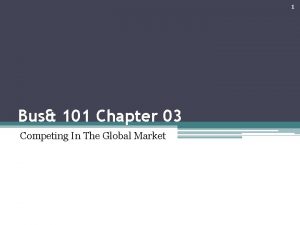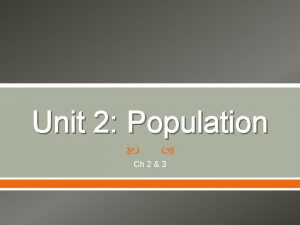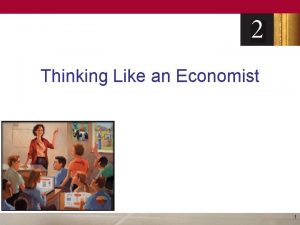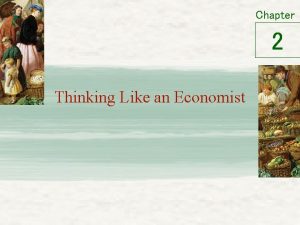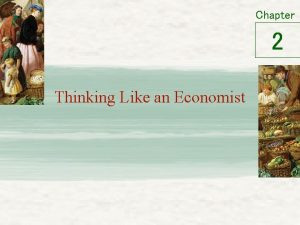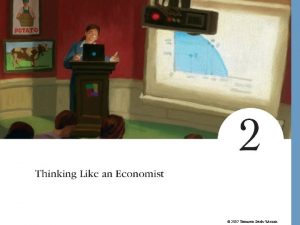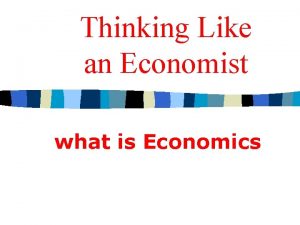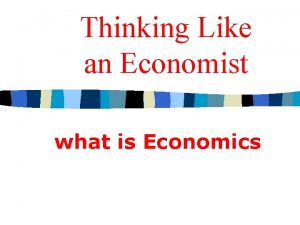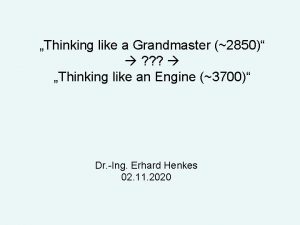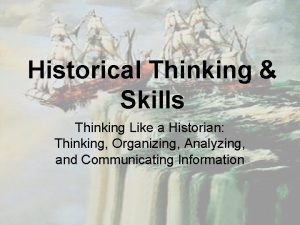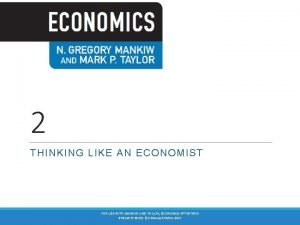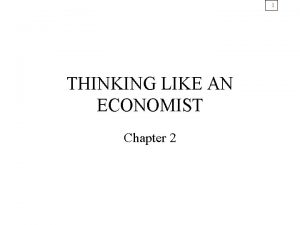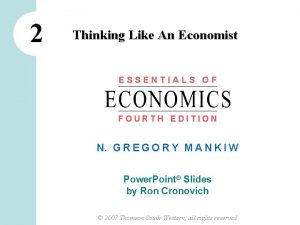Thinking Like an Economist Every field of study





















- Slides: 21

Thinking Like an Economist • Every field of study has its own terminology • Mathematics • integrals axioms vector spaces • Psychology • ego id cognitive dissonance • Law • promissory rights torts venues • Economics • supply opportunity cost elasticity consumer surplus demand comparative advantage deadweight loss

Thinking Like an Economist • Economics trains you to. . • Think in terms of alternatives. • Evaluate the cost of individual and social choices. • Examine and understand how certain events and issues are related.

THE ECONOMIST AS A SCIENTIST • The economic way of thinking. . . • Involves thinking analytically and objectively. • Makes use of the scientific method.

The Scientific Method: Observation, Theory, and More Observation • Uses abstract models to help explain how a complex, real world operates. • Develops theories, collects, and analyzes data to evaluate theories.

The Role of Assumptions • Economists make assumptions in order to make the world easier to understand. • The art in scientific thinking is deciding which assumptions to make. • Economists use different assumptions to answer different questions.

Economic Models • Economists use models to simplify reality in order to improve our understanding of the world • Two of the most basic economic models include: • The Circular Flow Diagram • The Production Possibilities Frontier

Our First Model: The Circular-Flow Diagram • The circular-flow diagram is a visual model of the economy that shows how dollars flow through markets among households and firms.

Figure 1 The Circular Flow MARKETS FOR GOODS AND SERVICES • Firms sell Goods • Households buy and services sold Revenue Wages, rent, and profit Goods and services bought HOUSEHOLDS • Buy and consume goods and services • Own and sell factors of production FIRMS • Produce and sell goods and services • Hire and use factors of production Factors of production Spending MARKETS FOR FACTORS OF PRODUCTION • Households sell • Firms buy Labor, land, and capital Income = Flow of inputs and outputs = Flow of dollars Copyright © 2004 South-Western

Our First Model: The Circular-Flow Diagram • Firms • Produce and sell goods and services • Hire and use factors of production • Households • Buy and consume goods and services • Own and sell factors of production

Our First Model: The Circular-Flow Diagram • Markets for Goods and Services • Firms sell • Households buy • Markets for Factors of Production • Households sell • Firms buy

Our First Model: The Circular-Flow Diagram • Factors of Production • Inputs used to produce goods and services • Land, labor, and capital

Our Second Model: The Production Possibilities Frontier • The production possibilities frontier is a graph that shows the combinations of output that the economy can possibly produce given the available factors of production and the available production technology.

Figure 2 The Production Possibilities Frontier Quantity of Computers Produced 3, 000 D C 2, 200 2, 000 A Production possibilities frontier B 1, 000 0 300 600 700 1, 000 Quantity of Cars Produced Copyright© 2003 Southwestern/Thomson Learning

Our Second Model: The Production Possibilities Frontier • Concepts Illustrated by the Production Possibilities Frontier • • Efficiency Tradeoffs Opportunity Cost Economic Growth

Figure 3 A Shift in the Production Possibilities Frontier Quantity of Computers Produced 4, 000 3, 000 2, 100 2, 000 0 E A 700 750 1, 000 Quantity of Cars Produced Copyright © 2004 South-Western

Microeconomics and Macroeconomics • Microeconomics focuses on the individual parts of the economy. • How households and firms make decisions and how they interact in specific markets • Macroeconomics looks at the economy as a whole. • Economy-wide phenomena, including inflation, unemployment, and economic growth

THE ECONOMIST AS POLICY ADVISOR • When economists are trying to explain the world, they are scientists. • When economists are trying to change the world, they are policy advisor.

POSITIVE VERSUS NORMATIVE ANALYSIS • Positive statements are statements that attempt to describe the world as it is. • Called descriptive analysis • Normative statements are statements about how the world should be. • Called prescriptive analysis

POSITIVE VERSUS NORMATIVE ANALYSIS • Positive or Normative Statements? ? ? • An increase in the minimum wage will cause a decrease in employment among the least-skilled. POSITIVE • Higher federal budget deficits will cause interest rates to increase. POSITIVE ?

POSITIVE VERSUS NORMATIVE ANALYSIS • Positive or Normative Statements? ? ? • The income gains from a higher minimum wage are worth more than any slight reductions in employment. NORMATIVE • State governments should be allowed to collect from tobacco companies the costs of treating smoking-related illnesses among the poor. NORMATIVE ?

WHY ECONOMISTS DISAGREE • They may disagree about the validity of alternative positive theories about how the world works. • They may have different values and, therefore, different normative views about what policy should try to accomplish.
 Thinking like an economist summary
Thinking like an economist summary Thinking like an economist ppt
Thinking like an economist ppt Thinking like an economist chapter 2
Thinking like an economist chapter 2 Thinking like an economist chapter 1
Thinking like an economist chapter 1 Chapter 2 thinking like an economist summary
Chapter 2 thinking like an economist summary Chapter 2 thinking like an economist summary
Chapter 2 thinking like an economist summary Thinking like an economist chapter 2
Thinking like an economist chapter 2 Every country and every nation
Every country and every nation Empower every person and every organization
Empower every person and every organization Every knee shall bow every tongue confess
Every knee shall bow every tongue confess Every rotarian every year
Every rotarian every year Every nation and every country
Every nation and every country Every picture has a story and every story has a moment
Every picture has a story and every story has a moment Every child every day
Every child every day Vilfredo pareto
Vilfredo pareto A wise economist asks a question
A wise economist asks a question Watergate
Watergate What does the cartoon imply about the open door policy
What does the cartoon imply about the open door policy The young economist's guide to professional etiquette
The young economist's guide to professional etiquette Jane carter labor economist
Jane carter labor economist Economist.com
Economist.com Economist.com
Economist.com
